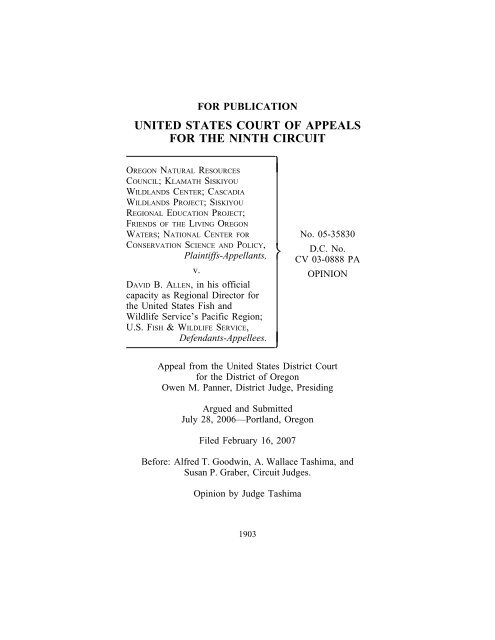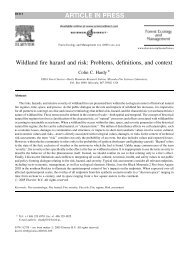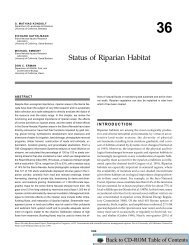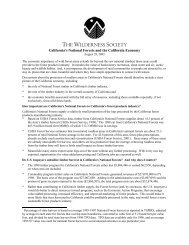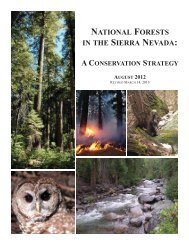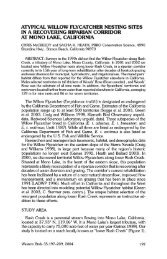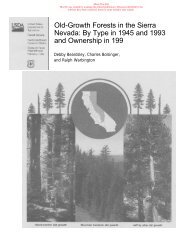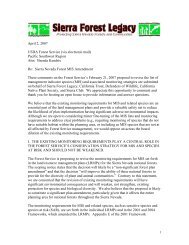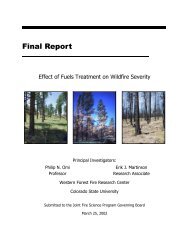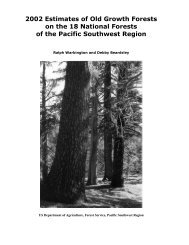oregon natural resources council v allen - Sierra Forest Legacy
oregon natural resources council v allen - Sierra Forest Legacy
oregon natural resources council v allen - Sierra Forest Legacy
You also want an ePaper? Increase the reach of your titles
YUMPU automatically turns print PDFs into web optimized ePapers that Google loves.
FOR PUBLICATIONUNITED STATES COURT OF APPEALSFOR THE NINTH CIRCUITOREGON NATURAL RESOURCESCOUNCIL; KLAMATH SISKIYOUWILDLANDS CENTER; CASCADIAWILDLANDS PROJECT; SISKIYOUREGIONAL EDUCATION PROJECT;FRIENDS OF THE LIVING OREGONWATERS; NATIONAL CENTER FOR No. 05-35830CONSERVATION SCIENCE AND POLICY,Plaintiffs-Appellants,v.⎫⎬DAVID B. ALLEN, in his officialcapacity as Regional Director forthe United States Fish andWildlife Service’s Pacific Region;U.S. FISH & WILDLIFE SERVICE,Defendants-Appellees.⎭D.C. No.CV 03-0888 PAOPINIONAppeal from the United States District Courtfor the District of OregonOwen M. Panner, District Judge, PresidingArgued and SubmittedJuly 28, 2006—Portland, OregonFiled February 16, 2007Before: Alfred T. Goodwin, A. Wallace Tashima, andSusan P. Graber, Circuit Judges.Opinion by Judge Tashima1903
1906 OREGON NATURAL RESOURCES v. ALLENCOUNSELKristen L. Boyles, Earthjustice, Seattle, Washington, for theplaintiffs-appellants.R. Justin Smith, U.S. Department of Justice, Environment andNatural Resources Division, Washington, D.C., for thedefendants-appellees.
OREGON NATURAL RESOURCES v. ALLEN1907Mark C. Rutzick, Portland, Oregon, for amicus curiae American<strong>Forest</strong> Resource Council.TASHIMA, Circuit Judge:OPINIONAs a result of this court’s opinion in Gifford Pinchot TaskForce v. United States Fish & Wildlife Service, 378 F.3d 1059(9th Cir. 2004), the Fish and Wildlife Service (“FWS”) voluntarilyreinitiated consultation with two federal agenciesregarding the impact of a portion of a proposed timber harveston the endangered northern spotted owl. The FWS accordinglywithdrew its favorable Biological Opinion (“BiOp” or“2001 BiOp”) regarding that portion of the timber harvest, butdid not withdraw the accompanying Incidental Take Statement,which would authorize the taking of “all” northern spottedowls associated with the full timber harvest. The OregonNatural Resources Council and several other conservationgroups (collectively, “ONRC”) ch<strong>allen</strong>ge the validity of thisIncidental Take Statement. We have jurisdiction under 28U.S.C. § 1291. We hold that the Take Statement is invalidbecause: (1) the withdrawal of a portion of the BiOp leavesthe Incidental Take Statement without an underlying factualpredicate; (2) the Incidental Take Statement presents a nonnumericalmeasure of take without explaining why no numberwas provided; and (3) the Incidental Take Statement sets ameasure of take that does not allow for reinitiation of consultation.I. BACKGROUNDThe Endangered Species Act (“ESA”), 16 U.S.C. §§ 1531-1544, evidences a congressional intent to afford endangeredspecies the highest of priorities. TVA v. Hill, 437 U.S. 153,194 (1978). “The plain intent of Congress in enacting this
1908 OREGON NATURAL RESOURCES v. ALLENstatute was to halt and reverse the trend toward species extinction,whatever the cost.” Id. at 184. To accomplish this ambitiousgoal, the ESA sets forth a comprehensive program tolimit harm to endangered species within the United States.Section 9 of the ESA establishes a blanket prohibition on thetaking 1 of any member of a listed endangered species. 16U.S.C. § 1538(a)(1)(B). Section 7 affirmatively commandseach federal agency to “insure that any action authorized,funded, or carried out” by the agency “is not likely to jeopardizethe continued existence of any endangered species . . . orresult in the destruction or adverse modification of habitat ofsuch species.” 16 U.S.C. § 1536(a)(2). However, § 7 carvesout limited exceptions for federal agencies and certainstatutorily-defined “applicants,” allowing those contemplatingaction that may harm endangered species to obtain a limitedexemption from penalties under certain circumstances. 2 16U.S.C. § 1536(a)-(c), (o); 50 C.F.R. § 402.02.Under § 7, if any listed (or proposed listed) species may bepresent in the area of the proposed action, the federal agency(the “action agency”) must conduct a biological assessment inorder to determine the likely effect of its proposed action onthe species. 16 U.S.C. § 1536(c)(1); see also 50 C.F.R.1 The ESA defines the term “take” as “to harass, harm, pursue, hunt,shoot, wound, kill, trap, capture, or collect, or to attempt to engage in anysuch conduct.” 16 U.S.C. § 1532(19). “Harm,” in this context, is “an actwhich actually kills or injures wildlife. Such act may include significanthabitat modification or degradation where it actually kills or injures wildlifeby significantly impairing essential behavioral patterns, includingbreeding, feeding or sheltering.” 50 C.F.R. § 17.3; Babbitt v. Sweet HomeChapter of Cmtys. for a Greater Or., 515 U.S. 687, 691 (1995).2 Section 10 of the ESA also authorizes the issuance of incidental takepermits to private parties. 16 U.S.C. § 1539. Historically, however, onlya small number of § 10 permits actually issue. See Ramsey v. Kantor, 96F.3d 434, 442 n.15 (9th Cir. 1996). Section 7 also establishes a limitedprocedure by which agencies may attempt to exempt a project from theESA by applying to the Endangered Species Committee. See 16 U.S.C.§ 1536(e)-(p); see generally Portland Audubon Soc’y v. Endangered SpeciesComm., 984 F.2d 1534 (9th Cir. 1993) (discussing Committee’s role).
OREGON NATURAL RESOURCES v. ALLEN§ 402.02. If the action agency concludes that its proposedaction may affect listed species or critical habitat, it must initiateconsultation with the FWS or the National Marine FisheriesService. See 50 C.F.R. § 402.14.In 2001, the Bureau of Land Management and the <strong>Forest</strong>Service (“agencies”) desired to conduct approximately 75timber sales on 64,006 acres of federally-managed land in thePacific northwest, primarily within the Rouge River Basin inOregon. These forests also house the northern spotted owl,strix occidentalis caurina, a listed threatened species. See 50C.F.R. § 17.11(h). The agencies conducted a biologicalassessment of the proposed sales and concluded that the salesmay affect the northern spotted owl, as well as three otherlisted species. The agencies initiated formal consultation withthe FWS.During the consultation process, the FWS assessed the proposedaction for its potential to harm the spotted owl andother endangered species and their critical habitat. See 50C.F.R. § 402.14(g). The FWS summarized its findings in aBiOp, issued in October 2001. See 50 C.F.R. § 402.14(g)-(h).The BiOp found that the proposed timber harvest wouldremove 22,227 acres of forest designated as spotted owl suitablehabitat (i.e., habitat suitable for nesting, roosting and/orforaging). The timber harvest would impact 10,443 acres ofspotted owl critical habitat, 3 removing or downgrading 5,3833 The FWS has designated a total of approximately 6.9 million acres offorest lands as the northern spotted owl’s “critical habitat,” i.e.:(i) the specific areas within the geographical area occupied by thespecies . . . on which are found those physical or biological features(I) essential to the conservation of the species and (II)which may require special management consideration or protection;and (ii) specific areas outside the geographical area occupiedby the species . . . upon a determination . . . that such areasare essential for the conservation of the species.190916 U.S.C. § 1532(5)(A); see Endangered and Threatened Wildlife andPlants; Determination of Critical Habitat for the Northern Spotted Owl, 57Fed. Reg. 1,796, 1,809 (Jan. 15, 1992).
1910 OREGON NATURAL RESOURCES v. ALLENacres of nesting, roosting, and foraging critical habitat,degrading 2,168 acres of nesting, roosting, and foraging criticalhabitat, removing 563 acres of dispersal 4critical habitatand degrading 2,329 acres of dispersal critical habitat. Nevertheless,the BiOp concluded, the anticipated harvest “[was]not likely to jeopardize the existence of the spotted owl . . .and [was] not likely to destroy or adversely modify designatedcritical habitat for the spotted owl.”When the FWS concludes that an action will not jeopardizethe existence of a listed species or adversely modify its habitat,but the project is likely to result in incidental takings oflisted species, the FWS must provide a written statement withthe BiOp that authorizes such takings. 16 U.S.C. § 1536(b)(4),(o); Ariz. Cattle Growers’ Ass’n v. U. S. Fish & Wildlife, 273F.3d 1229, 1233 (9th Cir. 2001). The Incidental Take Statementmust: (1) specify the impact of the incidental taking onthe species; (2) specify the “reasonable and prudent measures”that the FWS considers necessary or appropriate tominimize such impact; (3) set forth “terms and conditions”with which the action agency must comply to implement thereasonable and prudent measures (including, but not limitedto, reporting requirements); and (4) specify the procedures tobe used to handle or dispose of any animals actually taken. 16U.S.C. § 1536(b)(4); 50 C.F.R. § 402.14(i). As long as anytakings comply with the terms and conditions of the IncidentalTake Statement, the action agency is exempt from penaltiesfor such takings. 16 U.S.C. § 1536(o)(2). Thus, a BiOpwith a no-jeopardy finding effectively green-lights the proposedaction under the ESA, subject to the Incidental TakeStatement’s terms and conditions. See Bennett v. Spear, 520U.S. 154, 169-71 (1997) (noting that, while a BiOp is techni-4 According to the FWS, dispersal habitat consists of trees of adequatesize and canopy closure to protect owls from predators as they movewithin their range. 57 Fed. Reg. at 1,798. Although it may be marginal orunsuitable for nesting, roosting or foraging, dispersal habitat serves to linkowl subpopulations and blocks of owl nesting habitat. Id.
OREGON NATURAL RESOURCES v. ALLEN1911cally advisory only, an agency disregards the BiOp “at itsown peril”).However, the ESA’s implementing regulations require theagencies completing the project to report back to the FWS onthe action’s progress and its impact on the species “[i]n orderto monitor the impacts of incidental take.” 50 C.F.R.§ 402.14(i)(3). The agency must immediately reinitiate consultationwith the FWS if the amount or extent of incidentaltaking is exceeded. 50 C.F.R. §§ 402.14(i)(4), 402.16(a). 5The 2001 BiOp’s accompanying Incidental Take Statementauthorized the “incidental take of all spotted owls associatedwith the removal and downgrading of 22,227 acres of suitablespotted owl habitat.” The Reasonable and Prudent Measuresinclude the following statement: “The Service believes thatthe following reasonable and prudent measures are necessaryand appropriate to minimize the impacts of incidental take ofthe spotted owl . . . [:] Provide appropriate amounts of spottedowl dispersal and suitable habitat in a condition and distributionthat facilitates spotted owl movement across the landscape.”The Terms and Conditions specify procedures forhandling species specimens and require that certain of thetimber harvest projects be reviewed for consistency with theBiOp. The Terms and Conditions also require the agencies toreport annually on the “actual impacts of the proposed projects,”and state that “[i]f take is exceeded, consultation willhave to be reinitiated.”5 The action agency must also reinitiate consultation with the FWS if:(1) new information reveals effects of the action that may affect listed speciesor critical habitat in a manner or to an extent not previously considered;(2) a modification to the action affects listed species or criticalhabitat in a way that was not considered in the BiOp; or (3) newly listedspecies or newly designated critical habitat may be affected by the identifiedaction. 50 C.F.R. § 402.16(b)-(d).
1912 OREGON NATURAL RESOURCES v. ALLENII. PROCEEDINGS BELOWIn 2003, ONRC commenced this action, ch<strong>allen</strong>ging thevalidity of the BiOp and the Incidental Take Statement. Thedistrict court granted defendants’ motion for summary judgmentin February 2004, and ONRC appealed.While this case was pending on appeal, we decided GiffordPinchot. We held that the definition of “destruction or adversemodification” of critical habitat employed by the FWS inassessing jeopardy to the northern spotted owl violated theESA. Gifford Pinchot, 378 F. 3d at 1069-75. The definitionin use “set[ ] the bar too high” by finding adverse modificationonly where proposed actions impacted “both the survivaland recovery of a listed species.” Id. at 1069 (emphasisadded). We ordered this case remanded to the district courtfor consideration in light of Gifford Pinchot’s relevant holdings.See Or. Natural Res. Council v. Allen, 124 Fed. App’x555 (9th Cir. Mar. 9, 2005).The FWS subsequently acknowledged that Gifford Pinchotrendered a portion of the 2001 BiOp invalid. It voluntarilyreinitiated consultation on the land designated as northernspotted owl critical habitat, represented by the FWS to be5,383 acres. Based on this action, the district court found thatthe only live issue presented was the continuing validity of theIncidental Take Statement. The district court concluded thatthe original Incidental Take Statement remained valid despitethe partial withdrawal of the BiOp, and again granted summaryjudgment in favor of the FWS. ONRC again appeals thevalidity of the Incidental Take Statement, arguing that: (1) theFWS’ voluntary reinitiation of consultation on some of thetimber sales approved by the BiOp renders the IncidentalTake Statement invalid; and (2) the Incidental Take Statementfails to quantify adequately the authorized take of northernspotted owls or explain why no number was provided.
III. ANALYSISOREGON NATURAL RESOURCES v. ALLEN1913A. Standard of ReviewThe BiOp and its accompanying Incidental Take Statementrepresent final agency action subject to judicial review. Bennett,520 U.S. at 177-78. As the ESA does not itself specifya standard of review of its implementation, we apply the generalstandard of review of agency action established by theAdministrative Procedure Act (“APA”). See id.; 5 U.S.C.§§ 701-706. The Incidental Take Statement is thus subject toreview under the arbitrary and capricious standard found inthe APA. See 5 U.S.C. §§ 704, 706. We review the districtcourt’s grant of summary judgment de novo. N. Alaska Envtl.Ctr. v. Kempthorne, 457 F.3d 969, 975 (9th Cir. 2006). Thus,we must determine whether there is a rational connectionbetween the facts found and the choices made by the FWSand whether it has committed a clear error of judgment. Ariz.Cattle Growers’ Ass’n, 273 F.3d at 1243.Review under the arbitrary and capricious standard is to be“narrow,” but “searching and careful.” Marsh v. Or. NaturalRes. Council, 490 U.S. 360, 378 (1989). The Supreme Courthas explained that an agency action is arbitrary and capriciousif “the agency has . . . entirely failed to consider an importantaspect of the problem.” Motor Vehicle Mfrs. Ass’n v. StateFarm Mut. Auto. Ins. Co., 463 U.S. 29, 43 (1983). A courtcannot, however, substitute its judgment for that of the agencyor merely determine that it would have decided an issue differently.Marsh, 490 U.S. at 377.B. Withdrawal of a Material Portion of the BiOpRenders the Incidental Take Statement Invalid.ONRC contends that reinitiating consultation on the portionof the timber sales impacting northern spotted owl criticalhabitat materially changed the scope of the BiOp, necessitatinga new Incidental Take Statement. We agree. Even a cur-
1914 OREGON NATURAL RESOURCES v. ALLENsory review of the regulations governing formal consultationdemonstrates that Incidental Take Statements supplementBiOps, and were not meant to stand alone.[1] The FWS must issue an Incidental Take Statement if theBiOp concludes no jeopardy to listed species or adverse modificationof critical habitat will result from the proposedaction, but the action is likely to result in incidental takings.16 U.S.C. § 1536(b)(4); 50 C.F.R. § 402.14(i); Ariz. CattleGrowers’ Ass’n, 273 F.3d at 1242. Both the BiOp and theIncidental Take Statement must be formulated by the FWSduring the formal consultation process; indeed, the regulationsspecifically require the FWS to provide the Incidental TakeStatement “with the biological opinion.” 50 C.F.R.§ 402.14(g), (i)(1).The Incidental Take Statement must be associated with anunderlying BiOp because the Incidental Take Statement’s primaryfunction is to authorize the taking of animals incidentalto the execution of a particular proposed action. The approvalis effectively conveyed through the BiOp’s “no jeopardy”determination. See 50 C.F.R. § 402.14(g)-(h); Bennett, 520U.S. at 169-71. Without the “no jeopardy” determination containedin the underlying BiOp, the Incidental Take Statementpotentially pre-authorizes take for an action that could subsequentlybe determined to jeopardize the existence of anendangered species. Such a result would be contrary to theESA’s fundamental purpose and scheme. See 16 U.S.C.§§ 1531(b)-(c), 1538(a)(1)(B).Moreover, under the ESA’s implementing regulations, inorder to be considered a proper taking, the taking must beincidental to the purpose of the action. 50 C.F.R. § 402.02;see also 16 U.S.C. § 1536(b)(4) (providing for authorizationof takings incidental to approved agency actions). Withoutunderstanding the scope and purpose of the action itself —information contained in the BiOp — there is no way to knowwhether the take being authorized is properly “incidental.”
OREGON NATURAL RESOURCES v. ALLEN1915[2] The facts of this case acutely demonstrate the IncidentalTake Statement’s necessarily auxiliary nature. Here, the 2001BiOp initially approved timber sales impacting 22,227 acresof suitable habitat for the northern spotted owl. The FWS haswithdrawn its approval of the logging of at least 5,383 acresof critical habitat. However, the accompanying IncidentalTake Statement — contained within the 2001 BiOp — authorizedthe taking of all spotted owls associated with theremoval or downgrading of 22,227 acres of suitable spottedowl habitat, which may include most or all of the critical habitatacreage at issue. Thus, as it stands, the Incidental TakeStatement is now broader than the project and allows for thetake of more spotted owls than are affected by the remainingportions of the BiOp. Allowing the Incidental Take Statementto stand alone would also presuppose the reapproval of thetimber harvest on spotted owl critical habitat, even though theFWS has acknowledged that the action’s propriety must bereevaluated in the light of the proper definition of destructionor adverse modification of critical habitat.[3] Because there is no rational connection between theauthorization of take and the scope of the underlying proposedaction, we conclude that the Incidental Take Statementis arbitrary and capricious. See Ariz. Cattle Growers’ Ass’n,373 F.3d at 1243.C. The Incidental Take Statement Is Invalid Becausethe FWS Failed to Establish that it Could Not Seta Numerical Measure of Take.Congress has clearly declared a preference for expressingtake in numerical form, and an Incidental Take Statement thatutilizes a surrogate instead of a numerical cap on take mustexplain why it was impracticable to express a numerical measureof take. Because the Incidental Take Statement at issuecontains no numerical cap on take and fails to explain why itdoes not, it violates the ESA.
1916 OREGON NATURAL RESOURCES v. ALLEN[4] Section 7 of the ESA requires Incidental Take Statementsto specify the “impact” of the incidental takings on thespecies. 16 U.S.C. § 1536(b)(4)(i). In its discussion of§ 7(b)(4), Congress indicated that it preferred the IncidentalTake Statement to contain a numerical value: “Where possible,the impact should be specified in terms of a numericallimitation on the Federal agency or permittee or licensee.”H.R. Rep. No. 97-567, at 27 (1982), reprinted in 1982U.S.C.C.A.N. 2807, 2827. Congress recognized, however,that a numerical value would not always be available: “TheCommittee recognizes . . . it may not be possible to determinethe number of eggs of an endangered or threatened fish whichwill be sucked into a power plant when water is used as acooling mechanism. The Committee intends only that suchnumbers be established where possible.” Id.[5] Accordingly, we have recognized that the permissiblelevel of take ideally should be expressed as a specific number.See Ariz. Cattle Growers’ Ass’n, 273 F.3d at 1249 (referencing,as examples of numerical limitations, several cases inwhich the Incidental Take Statements stated the specific numberof species members that would be affected). Further, if itdoes employ some other measure, “the Fish and Wildlife Servicemust establish that no such numerical value could bepractically obtained.” Id. at 1250.[6] Contrary to the FWS’ argument, “quantifying” take interms of habitat acreage lost is simply not the type of numericallimitation on take contemplated by Congress or thiscourt’s precedent. Moreover, the BiOp offers no explanationof why the FWS was unable numerically to quantify the levelof take of northern spotted owls. The BiOp’s appendixdeclares that “spotted owl survey data are currently out-ofdateand surveys have been discontinued or reduced.” TheFWS, however, never states that it is not possible to updatethe survey data in order to estimate the number of takings,only that it has not actually done the surveys. This does notestablish the numerical measure’s impracticality. We there-
OREGON NATURAL RESOURCES v. ALLEN1917fore conclude that the FWS’ unexplained failure to complywith this requirement renders the Incidental Take Statementinvalid. See id.; cf. Ctr. for Biological Diversity v. Bureau ofLand Mgmt., 422 F. Supp. 2d 1115, 1137-38 (N.D. Cal. 2006)(finding that the FWS did not adequately establish that nonumerical value of take of desert tortoises could practically beobtained where Incidental Take Statement relied on fact thatthe Service simply had not estimated the number of desert tortoisesin the action area); Natural Res. Def. Council, Inc. v.Evans, 279 F. Supp. 2d 1129, 1184-85 (N.D. Cal. 2003)(rejecting Incidental Take Statement that failed to quantifynumerically the authorized incidental take of some twentyendangered species and offered no evidence that it wasimpractical to obtain such numerical estimates).D. The Incidental Take Statement Does Not Providefor Reinitiation of Consultation.[7] As discussed above, Congress preferred take “be specifiedin terms of a numerical limitation.” H.R. Rep. No. 97-567, at 27 (1982). A surrogate is permissible if no numbermay be practically obtained. The chosen surrogate, however,must be able to perform the functions of a numerical limitation.In particular, Incidental Take Statements “set forth a‘trigger’ that, when reached, results in an unacceptable levelof incidental take, invalidating the safe harbor provision [ofthe ESA], and requiring the parties to re-initiate consultation.”Ariz. Cattle Growers’ Ass’n, 273 F.3d at 1249. Because itwould allow the take of “all spotted owls” associated with theproject, the Incidental Take Statement would not allow forreinitiation of consultation and is therefore not a proper surrogate.[8] We have previously invalidated Incidental Take Statementsthat could not adequately trigger reinitiation of consultation.For example, in Arizona Cattle Growers’ Ass’n, weinvalidated an Incidental Take Statement because it did notcontain measurable guidelines to determine when incidental
1918 OREGON NATURAL RESOURCES v. ALLENtake would be exceeded. See id. at 1249-51. In that case, theFWS formally consulted with the Bureau of Land Managementregarding the proposed issuance of grazing permits. Id.at 1233-34. The FWS issued a BiOp containing several IncidentalTake Statements. One Incidental Take Statement, notingthat it would “be difficult to detect” incidental takings ofloach minnows from a particular allotment, instead attemptedto define the threshold of impermissible take using habitatcharacteristics. Id. at 1248. The Incidental Take Statementstated that it would consider the permissible level of take tobe exceeded if “[e]cological conditions do not improve underthe proposed livestock management” plan. Id. The IncidentalTake Statement then listed various components of the ecologicallandscape, the “improvement” of which would count asimproving “ecological conditions.” Id. at 1249.We explained that ecological conditions could be used asa surrogate for defining the amount or extent of take if theconditions were linked to the take of the protected species. Id.at 1250. If, however, the FWS chooses to employ a nonnumericalsurrogate, the surrogate must not be so general thatthe applicant or the action agency cannot gauge its level ofcompliance. Id. at 1250-51. The Incidental Take Statementfaltered because its directive to “improve” ecological conditionswas too vague for the permit applicant or the Bureau ofLand Management to measure its performance. Id. at 1250.Instead, the Take Statement purported to charge the applicantwith the general ecological improvement of 22,000 acres ofland. Id. at 1251. Because it did not set a clear standard fordetermining when the authorized level of take had beenexceeded, we held the Incidental Take Statement to be arbitraryand capricious. Id.; see also Natural Res. Def. Council,Inc., 279 F. Supp. 2d at 1185-87 (rejecting Incidental TakeStatement which purported to set the impermissible level oftake at “any individual” because, inter alia, such a take statementcould not trigger reinitiation of consultation, as it wasextremely unlikely that the taking of a single marine animalwould actually be detected); Nat’l Wildlife Fed’n v. Nat’l
OREGON NATURAL RESOURCES v. ALLEN1919Marine Fisheries Serv., 235 F. Supp. 2d 1143, 1160 (W.D.Wash. 2002) (finding that plaintiffs were likely to succeed ontheir claim that an incidental take surrogate that, “in effect,amounts to the project’s required work conditions,” wasinvalid).[9] The Incidental Take Statement in this case suffers fromthe same infirmity as the Incidental Take Statement in ArizonaCattle Growers’ Ass’n in that it too fails to set forth atrigger that would invalidate the safe harbor provision andreinitiate the consultation process. Here, the authorized levelof take, “all spotted owls associated with the removal anddowngrading of 22,227 acres of suitable spotted owl habitat,”cannot be reached until the project itself is complete. Even ifthe actual number of takings of spotted owls that occurredduring the project was considerably higher than anticipated,the Incidental Take Statement would not permit the FWS tohalt the project and reinitiate consultation. Instead, the permissiblelevel of take is coextensive with the project’s ownscope. 6 The Incidental Take Statement and BiOp are renderedtautological, they both define and limit the level of take usingthe parameters of the project. 76 Indeed, as discussed above, it actually exceeds the scope of the project,as the BiOp has been withdrawn with respect to the portion of the proposedharvest within the northern spotted owl’s critical habitat.7 This shortfall is exacerbated by the Incidental Take Statement’s failureto provide any meaningful measures to attempt to minimize incidental takingsassociated with the project. As a part of a take statement, the FWSmust specify “those reasonable and prudent measures that the [Service]considers necessary or appropriate to minimize such impact.” 16 U.S.C.§ 1536(b)(4)(ii); see also 50 C.F.R. § 402.14(i)(1)(ii). The measures maynot alter the project’s scope, but should be “minor changes” to the projectaimed at minimizing take, as required by § 7 of the ESA. 50 C.F.R.§ 402.14(i)(2). The FWS Section 7 Consultation Handbook provides asexamples concrete activities that may allow those implementing the projectto reduce the number of animals taken, such as education of employeesabout the species, reduction of predation of the species, removal or avoidanceof the species, or monitoring. Final ESA Section 7 ConsultationHandbook, March 1998 at 4-50.
1920 OREGON NATURAL RESOURCES v. ALLENThe FWS argues that, despite our holding in Arizona CattleGrowers’ Ass’n, Incidental Take Statements need not allowfor reinitiation of consultation. Instead, Incidental Take Statementsserve only to lift § 9’s bar on take. This interpretationof § 7(b)(4) ignores the limited nature of the take statement’sexemption from penalty. Further, it reads out the statutory andregulatory provisions for and congressional expectations ofthe monitoring of incidental take during the project.As discussed above, § 9 of the ESA issues a blanket prohibitionon the taking of any member of a listed species. 16U.S.C. § 1538(a)(1)(B). Section 7 and its implementing regulationsaffirm that this prohibition applies to federal agencies,and provide carefully limited exemptions. 16 U.S.C.§ 1536(o)(2). Throughout the biological assessment and formalconsultation process, it is incumbent upon the agency toshow that the project will not jeopardize or adversely affectthe critical habitat of any listed species. See 50 C.F.R.§§ 402.12, 402.14. Generally, the project may be exempt fromthe blanket prohibition on takings only if it does not place anylisted species in jeopardy and does not adversely modifylisted species’ critical habitat. 16 U.S.C. §§ 1536(b)(4), (o)(2).The exemption from liability for take is further limited bythe ESA’s implementing regulations. “Incidental take” mustbe truly incidental and may not be the purpose of the action.50 C.F.R. § 402.02. The take must be in compliance with theterms and conditions of the Incidental Take Statement. 50C.F.R. § 402.14(i)(5). Finally, the action agency must reiniti-Here, the Incidental Take Statement sets out only one Reasonable andPrudent Measure related to the spotted owl. It states that, to minimize take,a reasonable and prudent measure would be to “[p]rovide appropriateamounts of spotted owl dispersal and suitable habitat in a condition anddistribution that facilitates spotted owl movement across the landscape.”We are unable to extract any meaning from this sentence; neither the <strong>Forest</strong>Service, the Bureau of Land Management, nor the prospective loggers,will be able magically to “provide” habitat for the spotted owls.
OREGON NATURAL RESOURCES v. ALLEN1921ate consultation with the FWS if: (1) new information revealseffects of the action that may affect listed species or criticalhabitat in a manner or to an extent not previously considered;(2) a modification to the action affects listed species or criticalhabitat in a way that was not considered in the BiOp; or (3)newly listed species or newly designated critical habitat maybe affected by the identified action. 50 C.F.R. § 402.16(b)-(d).Thus, the ESA and its regulations seek to circumscribe andlimit the Incidental Take Statement’s exemption from liability.The regulations governing Incidental Take Statements alsoprovide for ongoing monitoring of incidental take by theaction agency and the FWS. 50 C.F.R. § 402.14(i)(3) instructsthe action agency or applicant to monitor the impacts of incidentaltake by reporting on the project’s impact on the species“as specified in the incidental take statement.” The regulationfurther instructs the action agency to reinitiate consultationimmediately if the amount or extent of specified take isexceeded in the course of the action. 50 C.F.R. § 402.14(i)(4).The FWS’ own Consultation Handbook terms this point “reinitiationlevel.” Final ESA Section 7 Consultation Handbook,March 1998 at 4-47. Thus, “[t]he terms of an Incidental TakeStatement do not operate in a vacuum. To the contrary, theyare integral parts of the statutory scheme, determining, amongother things, when consultation must be reinitiated.” Ariz.Cattle Growers’ Ass’n, 273 F.3d at 1251.Finally, the House Committee Report regarding the additionof § 7(b)(4) shows that, contrary to the FWS’ argument,Congress anticipated that Incidental Take Statements wouldallow for reinitiation of consultation: “If the specified impacton the species is exceeded, the Committee expects that theFederal agency or permitee or licensee will immediately reinitiateconsultation since the level of taking exceeds the impactspecified in the initial Section 7(b)(4) statement.” H.R. Rep.No. 97-567, at 27 (1982).
1922 OREGON NATURAL RESOURCES v. ALLENAuthorizing the take of “all spotted owls,” without anyadditional limit, is inadequate because it prevents the actionagencies from fulfilling the monitoring function the ESA andits implementing regulations clearly contemplate. The FWS’interpretation of the function of an Incidental Take Statementreads out of the statute the possibility of a revived consultation,rendering the monitoring and reinitiation provisions ofthe regulations meaningless. Its interpretation would impermissiblyexpand the Incidental Take Statement’s liabilityexemptions beyond the scope that has been established byCongress and by the ESA’s implementing regulations.[10] The FWS strenuously argues that its decision toemploy habitat as a surrogate for take is entitled to Chevrondeference and may not be disturbed by the Court. See ChevronU.S.A. Inc. v. Natural Res. Def. Council, Inc., 467 U.S.837 (1984). We agree that the FWS, in fashioning a new IncidentalTake Statement, may, in its discretion, certainly rely ona surrogate method, such as habitat, to determine the timberharvest’s impact on the spotted owl. The salient point here,however, is that no matter what kind of limitation on take theFWS chooses to place in the Incidental Take Statement, itcannot be so indeterminate as to prevent the Take Statementfrom contributing to the monitoring of incidental take byeliminating its trigger function.IV. CONCLUSION[11] We conclude that the Incidental Take Statement atissue in this case is arbitrary and capricious on several counts.First, because the underlying BiOp has been withdrawn, theIncidental Take Statement lacks a rational basis. Second, theTake Statement fails to provide a numerical limit on takewithout explaining why such a limit is impracticable to obtainand employ. Third, this Circuit has previously invalidatedIncidental Take Statements that could not adequately triggerreinitiation of consultation. The Incidental Take Statement ascurrently drafted could never trigger the reinitiation of consul-
OREGON NATURAL RESOURCES v. ALLENtation because, by definition, the permissible take level iscoextensive with the scope of the project.[12] For all these reasons, we reverse the judgment of thedistrict court and remand to the district court with instructionsto grant summary judgment in favor of plaintiffs regarding theinvalidity of the Incidental Take Statement.REVERSED and REMANDED with instructions.1923


